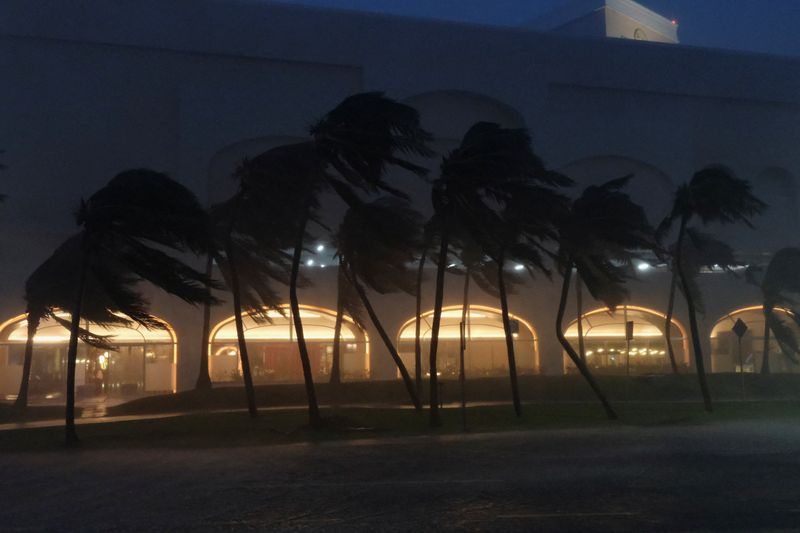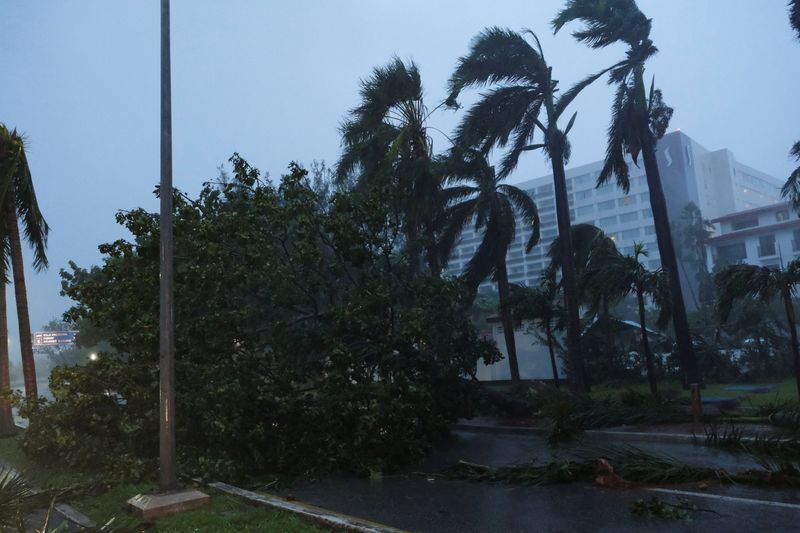
By Rich McKay and Brendan O’Brien
(Reuters) -Powerful storm Helene officially became a hurricane on Wednesday morning, the National Hurricane Center said, packing maximum sustained winds of 80 mph (130 kph) as it churned in the eastern Gulf of Mexico just off the coast of the Yucatan Peninsula.
Helene was expected to continue intensifying throughout the day and into Thursday, when it will likely bring life-threatening storm surge to much of Florida’s coastline as a major hurricane, according to forecasters.
More than 40 million people in Florida, Georgia and Alabama were under hurricane and tropical storm warnings, the National Weather Service said on Wednesday.
Numerous evacuations are being ordered along Florida’s Gulf coast, including Sarasota and Charlotte counties, and dozens of counties have announced school closures, including Hillsborough and Pinellas counties.
With weather reports playing on her television in the background, Melissa Wolcott-Martino, a retired magazine editor in St. Petersburg, was busy packing on Wednesday before evacuating her one-story coastal home and heading for higher ground.
Hours earlier, she had finally finished repairing the damage from last year’s Hurricane Idalia, which clobbered the low-lying area with powerful winds and devastating flood waters.
“We had Idalia last year,” the 81-year-old told Reuters by telephone. “We just finished the renovations, last touches today, and now we’re packing up for a new storm. This is not so great.”
Pinellas County officials ordered evacuations of long-term healthcare facilities, including nursing homes, assisted living centers and hospitals near the coast. The county sits on a peninsula surrounded by Tampa Bay and the Gulf of Mexico.
“Now, you still have time to prepare, review your hurricane plan, and make sure that you are executing your hurricane preparedness plan,” Gov. Ron DeSantis said in a Tuesday press briefing.
Helene lashed Cuba with heavy rains overnight, dumping as much as 8 inches (20.3 cm) in 24 hours across parts of the western tobacco-growing province of Pinar del Rio, the provincial meteorological service said.
Strong winds and rain flooded roads, tore roofs from homes and uprooted banana plants, destroying precious crops and prompting authorities to close schools and ports across much of the western half of the Caribbean island nation.
Cuban Caridad Contreras, 62, said her small town of Cortes, near the westernmost tip of Pinar del Río, was under siege as the storm continued to rage.
“Many of our crops have been destroyed,” she said.
CATEGORY 3
Helene was forecast to become a Category 3 storm – with winds of at least 111 miles per hour (178 kph) – before it makes landfall on Florida’s Big Bend region south of Tallahassee on Thursday evening, forecasters said.
The storm was expected to produce a dangerous 15-foot (4.6 m) storm surge in some areas. It was also expected to dump up to 15 inches (38.1 cm) of rain in some isolated spots in the region, causing considerable flash and urban flooding, the National Hurricane Center said.
“It is going to be a big storm,” NHC Deputy Director Jaime Rhome said at a press briefing on Tuesday. “It’s going to push a big swath of storm surge across the western portions of the Florida peninsula. This area is really, really vulnerable to storm surge.”
Residents in the potential path are being told to prepare to be without power for up to a week, Florida emergency officials said in a briefing.
In southwest Georgia, farmers were scrambling on Wednesday to save the cotton and pecan crops, said Pam Knox, an agriculture climatologist with the University of Georgia in Athens.

Farmers usually have weeks, not days to bring crops in, Knox told Reuters on Wednesday.
“This is going to be a billion dollar disaster,” said Knox.
This post is originally published on INVESTING.



